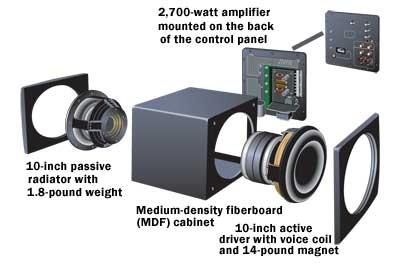Inner Workings: Inside a Compact Subwoofer

While subwoofers have been known to audiophiles since the '70s, the recent explosion of interest in 5.1-channel Dolby and DTS surround sound - where the ".1" LFE channel is dedicated to low-frequency effects such as explosions or thunder - has made them as common as lip-synced performances by pop stars. In most systems, the subwoofer's job is to reproduce low frequencies (typically between 20 and 100 Hz) that a system's main speakers can't handle as well or at all.
Most subs contain a driver or drivers, usually 8 to 15 inches in diameter but sometimes larger; a high-power amplifier (typically capable of 150 watts or greater output); and an electronic crossover with a low-pass filter to keep middle and high frequencies out of the sub. (In some subwoofers the crossover also includes a high-pass filter to keep low frequencies out of the main speakers.) Passive subwoofers, which don't have built-in amplifiers, are also available but much less common.
To produce a lot of bass, you have to move a lot of air. Historically, that's meant using a big driver housed in a big enclosure. But a more recent trend, popularized by Sunfire's powerful but diminutive True Subwoofer, is to use smaller "high-excursion" or "long-throw" drivers. (These terms refer to the distance a speaker cone moves in and out.)
Invented by legendary audio designer Bob Carver, the True uses a 10-inch driver with a very long - 2.5-inch - excursion (roughly five times that used of a conventional 15-inch driver) coupled with a similarly configured passive radiator. That amount of movement required Sunfire to develop new driver surrounds, suspensions, and even a new magnet structure and voice coil. (The magnet in the True Subwoofer's active driver is a 14-pound giant.) The passive radiator does not have a magnet or voice coil and is not connected to the amplifier. Instead, its diaphragm is attached to a 1.8-pound weight and moves in response to the back-pressure created by the active driver's movement. It functions like the port in a bass-reflex subwoofer, except that a passive radiator offers the designer a wider range of tuning options. This approach has allowed Sunfire to create very small subs (9-, 11-, and 13-inch cubes) that nonetheless pack tremendous low-end wallop.
But it takes a lot of power to overcome the high internal air pressure created inside the small enclosures. So Carver designed a hyperefficient amplifier built around what he calls a Tracking Downconverter (essentially an amp that monitors transient power requirements), which can generate very high levels of power into low-impedance loads without overheating. For example, the True Subwoofer's amp can deliver 2,700 watts of power into a 4-ohm load! If that much power were sustained, it would destroy any sub. Fortunately, both music and home theater require large amounts of power only in short, intermittent bursts.
All this wizardry - plus an active and passive crossover - is hidden inside the cube's medium-density fiberboard (MDF) enclosure. Because the True is much smaller than most conventional subs, you can put it places where larger subs won't fit.























































